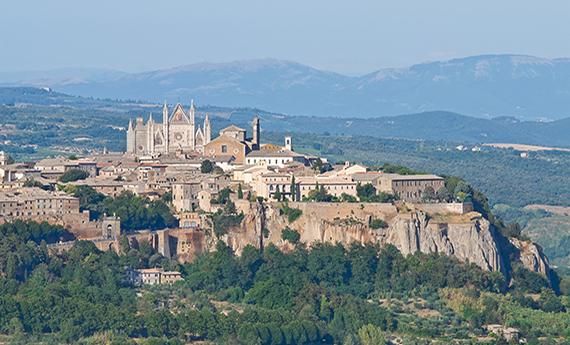Department Students Dig In!
July 13, 2022
Dr. Amanda K. Chen Leads a Team of Testudos to Italy for a Summer Dig Outside Orvieto
"You've just graduated from the University of Maryland with a bachelor's degree in Art History and Archaeology! What are you going to do next?"
For a few newly-minted Department graduates just this past May, along with some rising seniors in the program and related-fields (like Architecture), the answer clearly was "I'm going to Orvieto to dig!" Led by Dr. Amanda K. Chen, a veteran of digs in Italy (especially in Orvieto) and herself a fresh graduate of the Department, students embarked in June on a six-week excavation program of Corigilia (just outside Orvieto), which wraps up soon.
The program is organized by Saint Anselm College and they have been managing the excavation of this ancient 9th-century BCE Etruscan-Roman site for nearly two decades. Apart from a pause necessitated by the pandemic, Amanda has been a part of this program for five years, but this year marks the first time she has recruited such a robust number of Maryland students to participate.
Taking time in her off-hours in Orvieto, Amanda shared a bit about the experiences of the students and more about the program.
What is the program?
The Coriglia Excavation Project is an archaeological excavation and field school that explores the site of Coriglia in Orvieto, Italy. We conduct excavations, archaeological research, scientific analysis, and object conservation. In addition to research, we are also a field school. This means we invite any students or interested individuals to join the project as volunteers. Field school crew members learn the fundamentals of archaeological practice and research and play a key role in the program!
What cultures are the focus of the dig?
Evidence of habitation at Coriglia spans the Etruscan through early modern periods (ca. 14th century CE). The major periods of focus are the Etruscan and Roman phases, and this year we are actively excavating Etruscan, Imperial Roman, and late Roman areas on site. After the medieval period, olive groves were planted on site and the area was given over to agricultural activity.
Who all is participating?
The UMD crew includes Nicole Kaff, Haley Stone, Anastasia Hern, Isabella Chilchoat, Hanna Katulski, and Lizzy Gamble.
What's a typical day?
The most exciting part of working on an archaeological excavation is that no two days are the same, and you never know what you will discover on a given day! It could be bucket-loads of rocks and soil, or an artifact that is the key to the site!
That said, on a typical day we arrive on site in the morning and immediately get to work. We set a daily goal, explain the plan to students and rotate everyone through different tasks. Depending on the locus (distinct archaeological layer) we may use trowels and dental tools for fine work, or pickaxes and shovels. Each day, students and staff work to better understand the individual layers, the site as a whole, and uncover new and exciting artifacts. By the end of the season, the students can expertly identify a wide variety of artifacts, materials, and methods, and have perfected their skills with the trowel, pick, and shovel. The work is hard but rewarding!
How can one participate?
Get in touch! Applications for next season will go up around February 2023, but please feel free to reach out to me at akchen@umd.edu before then to talk about the excavation and field school.
Where is the dig?
Just outside of Orvieto, which is a town situated atop a large tufa outcropping, in central Italy (Umbria), just about an hour north of Rome.
More about you?
I recently completed my PhD in the Department of Art and Archaeology at UMD. I am a specialist of Roman art and archaeology, with a particular focus on the visual culture of ancient south Italy and will join the Kansas City Art Institute in the fall as Assistant Professor of Ancient Roman Art.
Thanks so much Amanda (Dr. Chen). We wish you much success in Kansas City!
You may also want to check out: Archaeology Minor


